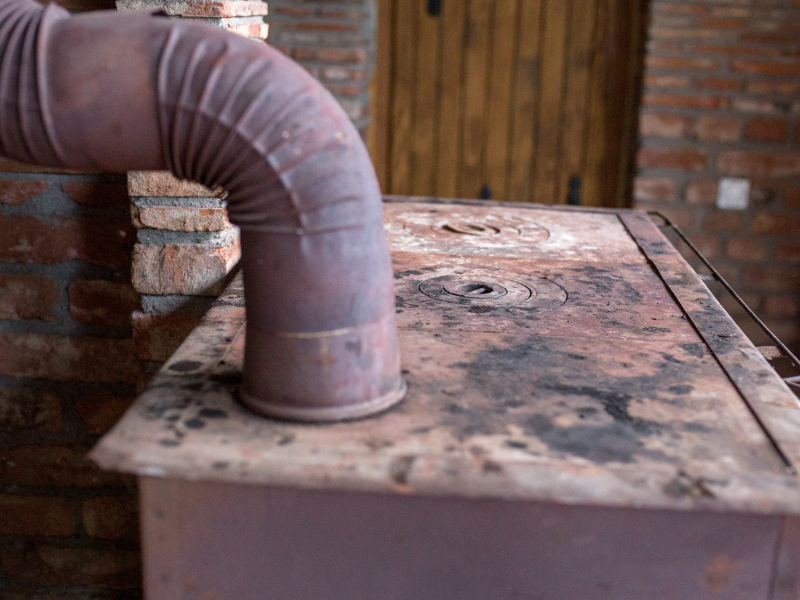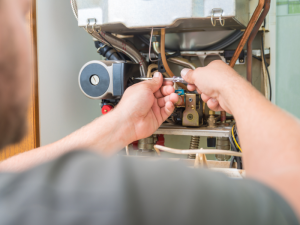Also occasionally referred to under the umbrella term of a “heater”, furnaces are one of the two main HVAC systems that heavily impact your home’s daily comfort.
The furnace itself is the main source of most of the heating, and is able to release thousands of BTU to heat a home. However, there are many different types of furnace units, each using a different kind of fuel or method for heating air.
This allows many homeowners to choose and decide between what kind of furnace they want and what would better suit their home. While you might already have a furnace built into your current home, many people also decide to upgrade to a new model or switch to a different type of furnace.
So, look through this guide of the different types of furnaces and pick which best suits your needs. If you’re interested in upgrading or switching, just contact our team at Clover Contracting for reliable installation work.
Electric Furnaces
If you’re looking for one of the furnace types that’s both eco-friendly and effective in heating a home, look no further than electric furnaces. As the name suggests, electric furnaces draw on the electricity that’s supplied to your home to work.
Since they don’t require any connections to the home’s gas lines, this kind of furnace is far more common to find, though it can also be more expensive.
Electric-powered models, like other types of furnace units, are formed out of a blower, its motor, and a set of heat strips. While there are many other parts as well, these are the ones that are the most important in how the furnace works.
When your home’s thermostat reads the temperature has dropped below the set level, it turns the heating strips on and draws in air. The blower then simply blows the now-hot air through the vents and into your home.
Natural Gas Furnaces
Another great option for a furnace is the natural gas furnace. Though considered one of the oldest types of furnaces for homes, these furnaces are also incredibly sturdy and long-lasting. With the proper care and regular maintenance that many HVAC companies – including our team at Clover Contracting – recommend, a natural gas furnace can last for 25 years or longer!
Though technically not as environmentally friendly as electric furnaces, natural gas is, in fact, far better for the environment than expected. These furnaces use a natural, gaseous mix of carbon and hydrogen to heat air, making it capable of drastically reducing the amount of pollution the furnace releases.
Natural gas furnaces also tend to save money on the energy it uses, since the gas mixture is both readily available and quite cheap.
Propane Furnaces
If you’re looking into one of the types of furnace units that can be used to quickly heat a home, propane furnaces are a great choice, especially for larger sized homes.
To work, the furnace uses liquid propane, much like a propane grill. The liquid fuel is turned into a gas first, then brought into the furnace’s heating chamber to heat the air. And, since burning propane creates far more heat than other fuel, the air is often much hotter.
The furnace’s use of propane also helps in making the furnace just a bit safer to use than other kinds. Since many propane tanks have safety measures put into place, the furnace also often has these measures in place. Additionally, while propane can be quite cost-effective and easy to get, propane furnaces can also be switched to using natural gas if its initial fuel becomes too costly or even runs out.
Waste Oil Furnaces
Another good variety in the different types of furnace units homeowners might be interested in is the waste oil furnace.
As the name suggests, waste oil furnaces burn the excess oil that you no longer need for heat. This specific type of “waste oil” can be any kind of oil as well, from old and overused vegetable oil to discarded automobile oil. Whatever oils you can’t use for their intended use can be put into a waste oil furnace.
This, naturally, makes waste oil furnaces a far more environmentally friendly option for heating homes than even some electric furnaces. By simply using discarded oil as a fuel source, it prevents those remnants from ending up in a dump or somewhere worse. And, to make the deal even more enticing, waste oil furnaces also tend to take up far less space than other units.
Single-Stage vs. Two-Stage Furnaces
Two furnace categories you might be interested in are single-stage and two-stage furnaces. As the names suggest, a single-stage furnace only has a single setting: on. This often means that the furnace outputs the same level of heat whenever you turn it on, regardless of the time of the year. Due to its 80% fuel efficiency, single-stage furnaces are great for smaller homes.
On the other hand, two-stage furnaces have two settings. Much like single-stage furnaces, this furnace has one setting that uses its maximum heating ability. In its second setting, though, two-stage furnaces only use roughly half of it. This allows the furnace – and to an extent, the homeowner – to control the flow of fuel better. The result is far more efficient heating that’s ideal for larger homes.
Takeaway
There is a far greater range of furnaces that can be invested in, though few of these units are used for heating homes. The furnaces that we’ve mentioned above are by far the most used in homes’ central heating systems. They provide nearly all the heat that a home needs, and in some cases, can even provide far more.
Ultimately, choosing the right furnace and the right fuel source for it can be a longer process than it might seem at first. The climate and location of where your home is situated can play a big role in the amount of heating that you can use. Furnaces that provide more heat can end up costing you more in the long run, especially if you don’t use much of it.
At the end of the day, contacting our team at Clover Contracting is the best choice, since we also make sure to help give you options that suit both your needs and your financial situation.




